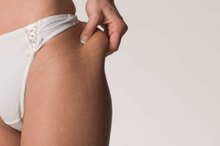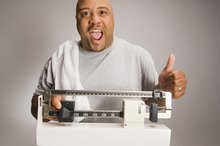What does fact checked mean?
At Healthfully, we strive to deliver objective content that is accurate and up-to-date. Our team periodically reviews articles in order to ensure content quality. The sources cited below consist of evidence from peer-reviewed journals, prominent medical organizations, academic associations, and government data.
- CDC: Balancing Calories
- CDC: Physical Activity for a Healthy Weight
- CDC: Losing Weight
- American Council on Exercise: Why is the Concept of Spot Reduction Considered a Myth?
- Mayo Clinic: Strength Training: Get Stronger, Leaner, Healthier
The information contained on this site is for informational purposes only, and should not be used as a substitute for the advice of a professional health care provider. Please check with the appropriate physician regarding health questions and concerns. Although we strive to deliver accurate and up-to-date information, no guarantee to that effect is made.
How to Get Rid of a Fat Pad
The fat pad is a nicer name associated with the accumulation of fat on the lower abdominal area. This area is prone to men and women who are overweight, and while many infomercial products claim to rid fat accumulation in this area, localized fat spot reduction is not possible. Spot reduction is a myth suggesting it is possible to lose weight in a specific area by performing certain exercises; however, the American Council on Exercise states spot reduction is impossible and the only way to remove weight from one area is to engage in regular exercise and a low-calorie diet.
Eat a low-calorie diet rich with nutritious foods, such as lean meats, vegetables, fruits and whole grains. Don’t give in and follow a fad diet, as healthy weight loss is a lifestyle change and not a temporary diet. The Centers for Disease Control and Prevention, or CDC, states that fad diets can limit healthy calorie intake, which may cause you to loose weight but in an unhealthy way. Monitor the amount of calories you consume, and if you have a goal of loosing up to 2 lbs. of fat per week, you’ll need to reduce your daily caloric intake by 500 to 1,000 calories, according to the CDC.
How to Tone Fat Knees
Learn More
Perform at least 150 minutes of moderate cardiovascular exercise per week, or 75 minutes of intense cardiovascular exercise per week in conjunction with a reduced calorie diet to loose body fat and maintain your weight. An example of moderate cardio exercise include brisk walking, casual biking and even yard work, while intense cardio exercise include jogging, jumping rope or swimming. Cardiovascular exercise calls upon stored fat cells to give the body energy for the task at hand, thus emptying fat cells throughout your body; including your fat pad.
Engage in strength training several times per week to build muscle mass and strengthen your body. Strength training is any exercise that isolates a group or several groups of muscles and uses external weight, such as dumbbells, to fatigue the muscles. Not only does strength training build muscle fiber, but also helps promote strong bones as well as increase your mental focus.
Does the Stairmaster Help Reduce Cellulite?
Learn More
Perform lower abdominal exercises, such as leg lifts, at least three times per week to strengthen and develop your lower abdominal muscles. While performing abdominal exercises alone will not rid your fat pad, in combination with a healthy diet, cardio and strength training you can reduce the size of the fat pad and other fat deposits throughout your body.
Tips
If you are a beginner at strength training, use weight machines instead of free weights as machines guide your movements to help prevent injury.
Warnings
Never engage in an exercise routine or a diet alteration without first consulting the changes with your doctor; especially if you have a medical condition or are on medication.
Related Articles
References
- CDC: Balancing Calories
- CDC: Physical Activity for a Healthy Weight
- CDC: Losing Weight
- American Council on Exercise: Why is the Concept of Spot Reduction Considered a Myth?
- Mayo Clinic: Strength Training: Get Stronger, Leaner, Healthier
- Katcher HI, Legro RS, Kunselman AR, et al. The effects of a whole grain-enriched hypocaloric diet on cardiovascular disease risk factors in men and women with metabolic syndrome. Am J Clin Nutr. 2008;87(1):79-90.
- Slentz CA, Aiken LB, Houmard JA, et al. Inactivity, exercise, and visceral fat. STRRIDE: a randomized, controlled study of exercise intensity and amount. J Appl Physiol. 2005;99(4):1613-8.
- Trapp EG, Chisholm DJ, Freund J, Boutcher SH. The effects of high-intensity intermittent exercise training on fat loss and fasting insulin levels of young women. Int J Obes (Lond). 2008;32(4):684-91.
- Vadstrup ES, Petersen L, Sørensen TI, Grønbaek M. Waist circumference in relation to history of amount and type of alcohol: results from the Copenhagen City Heart Study. Int J Obes Relat Metab Disord. 2003;27(2):238-46.
- You T, Berman DM, Ryan AS, Nicklas BJ. Effects of hypocaloric diet and exercise training on inflammation and adipocyte lipolysis in obese postmenopausal women. J Clin Endocrinol Metab. 2004;89(4):1739-46.
Resources
Tips
- If you are a beginner at strength training, use weight machines instead of free weights as machines guide your movements to help prevent injury.
Warnings
- Never engage in an exercise routine or a diet alteration without first consulting the changes with your doctor; especially if you have a medical condition or are on medication.
Writer Bio
Jonathan McLelland has been a professional writer since 2005. He has worked as a story writer and editor for the international sitcom, “Completing Kaden,” as well as a proposal writer for various production companies. McLelland studied communication and theater at St. Louis Community College.









